- About Us
- Columns
- Letters
- Cartoons
- The Udder Limits
- Archives
- Ezy Reading Archive
- 2024 Cud Archives
- 2023 Cud Archives
- 2022 Cud Archives
- 2021 Cud Archives
- 2020 Cud Archives
- 2015-2019
- 2010-2014
- 2004-2009
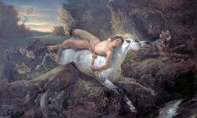 |
The Truth in Art |
Recently the question “What is truth in Art?” has been raised. For a greater part of the last decade I have been consumed with the question of the nature of Art, and thought little, if nothing, of the notion that Truth is fundamental to what Art seeks to express or embody. Thus, the question becomes what is the nature of the Truth that Art exposes to its audience.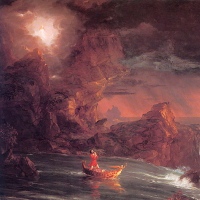 Just as with the nature of Art itself, I have been greatly concerned with the transcendent nature of that which Art tries to achieve and embody in the temporal and material world. But all along that has been the answer to why Art is itself transcendent and strives toward the universal in its expression: the Truth embodied in Art is the masterpiece of the temporal and the material, the natural and the spatial.
Just as with the nature of Art itself, I have been greatly concerned with the transcendent nature of that which Art tries to achieve and embody in the temporal and material world. But all along that has been the answer to why Art is itself transcendent and strives toward the universal in its expression: the Truth embodied in Art is the masterpiece of the temporal and the material, the natural and the spatial.
There is one fundamental reason why, in my eyes, the Romantics of the early nineteenth century have historically been the most fascinating group of artists and poets—their simultaneous obsession with the divine and the human, and the dynamic between these experienced within the self and through Art and Nature.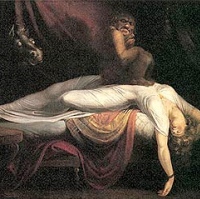 The Romantics knew that the human contained within itself the foundational presence of the Divine, but that it was all too great a burden and a terrible fate that our humanness prevented us from conquering the instinctual nature of man, liberating to its fullness the divinity in our souls. The Romantics were quintessentially in rapture over the beauty of our humanness, even in all its stark ugliness, and over the Great Divide between being wholly bestial and wholly divine, which, while the soul is bound to the flesh, cannot be bridged in the figure of man or by anything that man can do or create, not even Art itself.
The Romantics knew that the human contained within itself the foundational presence of the Divine, but that it was all too great a burden and a terrible fate that our humanness prevented us from conquering the instinctual nature of man, liberating to its fullness the divinity in our souls. The Romantics were quintessentially in rapture over the beauty of our humanness, even in all its stark ugliness, and over the Great Divide between being wholly bestial and wholly divine, which, while the soul is bound to the flesh, cannot be bridged in the figure of man or by anything that man can do or create, not even Art itself.
This is the “truth” of Art. Our humanness, our life within the confines of the temporal and in the materiality of the flesh, is the truth of Art; it alone is the story and history of Art; it alone is the history of civilization and the history, the narrative, of Time itself.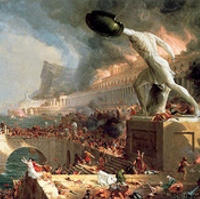 We embody Time. We create Art. Art narrates stories, it speaks, and the tale it tells is the history of Time in progress, unraveled and rewound to get at the truth of man: as human beings, we ourselves are the story of Time; we move through Time, we experience the movement of Time as live and endure, and yet we exist, unknowingly, as the vestiges of Time immemorial, past, present and future, and it is Art that shows this to us.
We embody Time. We create Art. Art narrates stories, it speaks, and the tale it tells is the history of Time in progress, unraveled and rewound to get at the truth of man: as human beings, we ourselves are the story of Time; we move through Time, we experience the movement of Time as live and endure, and yet we exist, unknowingly, as the vestiges of Time immemorial, past, present and future, and it is Art that shows this to us.
The truth in Art is the character, the personality, of Man. Art has shown humanity its humanness. Art does not hold a mirror up to Nature, but to Man himself, the most odd and mysterious invention of the Divine born in the womb of Nature. To some we are nothing but soulless beasts ranging over a ball spinning recklessly through the universe, with no goal but eventual self-annihilation that will take the Earth with us.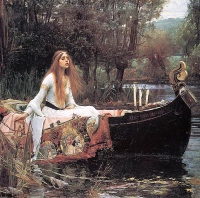 To others we have a flame of divinity in the very center of our being, yearning for freedom from the limitations of the flesh and what is most natural and beautiful about us, desiring oneness in Eternity with the God the others do not believe in. And then there are those others, the last group, few in number, who are awed both with terror and sublimity at the beauty and the ugliness, the hopelessness and the compassion that rattles the minds and hearts of humanity; who believe that our humanness is what, in itself, is beautiful, the gift that numbs the mind, confuses the heart, and brands the soul. It is this last group who believe we should not long for anything outside ourselves but knows we should believe in what is beyond ourselves. This group believes we should revere and take the greatest joy and pleasure in the individuality of what it means to be human, not wholly divine, nor wholly bestial, but knowing full well we are a grand, God-ordained mixture, an experiment, of both of these forms, which we, for lack of a better word, call human. This is the Truth that Art illuminates for humankind. Art is the story of our lives in Time, in the flesh, of the endless quest of man to find himself outside himself, when where he has been meant to look all along is within himself, and from what is within, all the inherently natural ugliness, sin, and beauty, take what makes him human and create an image, Art, which, because it does not share completely in our humanness, stands outside Time, and so shows us to ourselves with an objectivity that man cannot find within.
To others we have a flame of divinity in the very center of our being, yearning for freedom from the limitations of the flesh and what is most natural and beautiful about us, desiring oneness in Eternity with the God the others do not believe in. And then there are those others, the last group, few in number, who are awed both with terror and sublimity at the beauty and the ugliness, the hopelessness and the compassion that rattles the minds and hearts of humanity; who believe that our humanness is what, in itself, is beautiful, the gift that numbs the mind, confuses the heart, and brands the soul. It is this last group who believe we should not long for anything outside ourselves but knows we should believe in what is beyond ourselves. This group believes we should revere and take the greatest joy and pleasure in the individuality of what it means to be human, not wholly divine, nor wholly bestial, but knowing full well we are a grand, God-ordained mixture, an experiment, of both of these forms, which we, for lack of a better word, call human. This is the Truth that Art illuminates for humankind. Art is the story of our lives in Time, in the flesh, of the endless quest of man to find himself outside himself, when where he has been meant to look all along is within himself, and from what is within, all the inherently natural ugliness, sin, and beauty, take what makes him human and create an image, Art, which, because it does not share completely in our humanness, stands outside Time, and so shows us to ourselves with an objectivity that man cannot find within.
